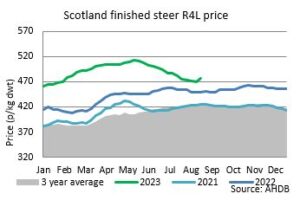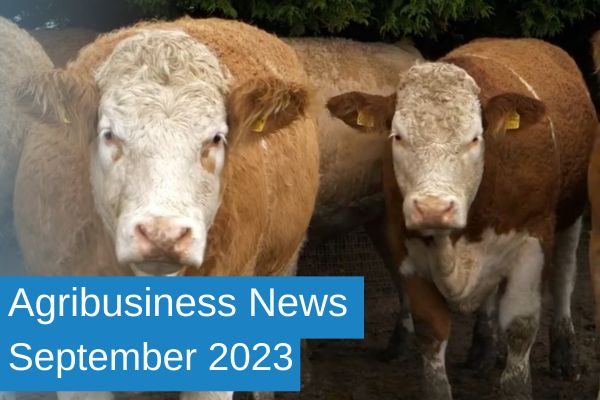Agribusiness News September 2023 – Beef
1 September 2023Beef price levelling out?
Throughout June and July, deadweight beef prices in Scotland have fallen significantly from a peak of 525p/kg at the beginning of June. Beef prices have continued to fall throughout August, as a result of larger supplies, lower import prices and poor consumer demand due to school holidays with consumers holidaying abroad. 469p/kg/dwt is now being quoted in Scotland for R4L steers.
It is anticipated that once the schools return in September prices will increase. Going forward cattle numbers will continue to tighten, due to the peak young bull selling period now over and supplies of spring 2021 born cattle dwindling. Lower cattle availability will offer support to price, as processors look to increase prices in order to secure cattle.
Despite a fall in in finished price, trade for store cattle has remained fairly steady, with July weather hampering combines rolling out sheds, store cattle were keenly bid for. However good weather in recent weeks, has seen store trade dip slightly, as harvest keeps buyers away from the ring.
Store trade
Demand continues to be high for shorter keep stores whilst smaller stores are noticeably cheaper. English buyers continue to support Scottish store sales, with availability south of the border and TB risks meaning finishers are coming North. This is encouraging to keep the market healthy as we head towards the big autumn calf sales, where some finishers could well be cautious, off the back of the falling beef price and with several finishers having made a loss on store cattle bought at their highest levels back in the Spring.
Although variable costs such as feed and fertiliser have started to return to a reasonable level, margins remain tight across many farms as labour and veterinary costs remain high with bank interest rates increasing.

Cull cows supply vs demand
Cull cow values have seen a sharp fall in the first half of August. With no BBQ weather and consumers abroad, retail demand for manufacturing beef has not been there. With numbers available for slaughter reported to be trending seasonally higher (there are still farmers looking to sell older, less productive animals), it is unlikely that prices will rise in the coming weeks, and with milk prices looking to drop, cull cow numbers could quickly rise. For those with spring calvers, scanning early to get empty cows offloaded before any potential dip in trade pre housing when seasonally higher numbers of cows are expected would be advised.
Looking forward
Going forward farm businesses will need to plan ahead and budget, however difficult this might be due to market volatility.

Sign up to the FAS newsletter
Receive updates on news, events and publications from Scotland’s Farm Advisory Service

